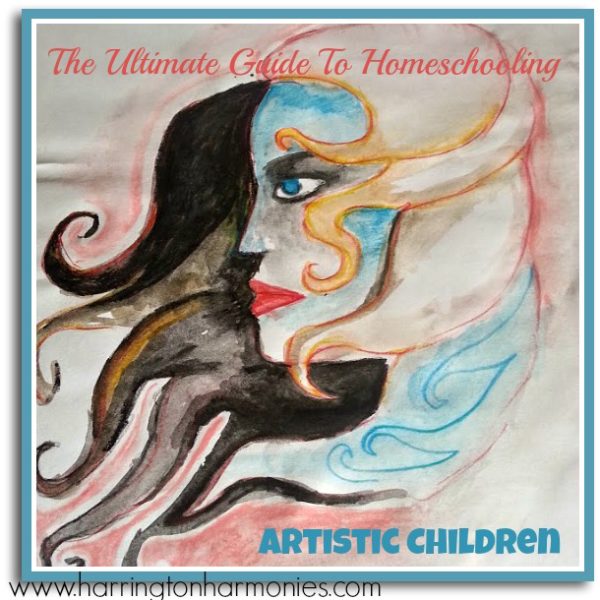 Are your children creative? imaginative? inventive? expressive? Do they have natural creative ability? Then they are artistic children.
Are your children creative? imaginative? inventive? expressive? Do they have natural creative ability? Then they are artistic children.
My oldest children are exceptionally creative. Not just because of the art skill they possess, but because they look at life in an artistic way. They are adults now and my job homeschooling them is complete. Their “giftedness” sometimes made them easier to homeschool, both of them being very bright. Other times, it made it much more difficult. As with most exceptionally artistic kids, they are twice exceptional. For many reasons, I am so glad I homeschooled them. Though it wasn’t always easy, I KNOW it was the right choice. Adjusting my methods and style to an artistic approach was the best thing I ever did and ensured our homeschool success.
One of my daughter’s eighth grade paintings:
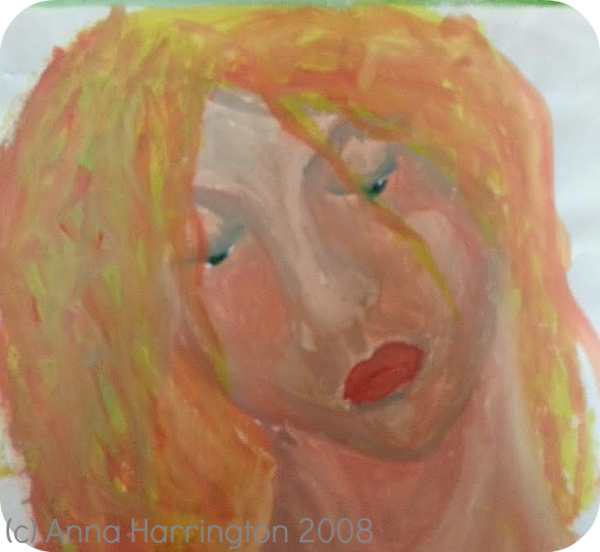 Homeschooling Artistic Children is mostly about helping them discover life.
Homeschooling Artistic Children is mostly about helping them discover life.
Homeschooling artistic children, like all children, is simply about helpings them figure life out and learn about things as they go. Of course, educating them in the basic skills of reading, writing and arithmetic are always the highest priority. We want our kids to be able to communicate effectively, become hard working contributing members to society, and develop skills to get them through life. Passing on the fundamentals of faith is also important, because faith and grace will get them through the hard times in their lives and they will ultimately have the resiliency to weather difficulties.
What’s all that have to do with the arts? Everything!
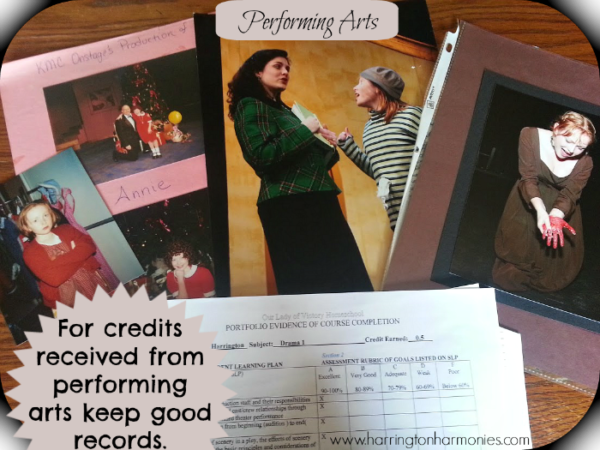 All of life is integrated. It’s a package deal.
All of life is integrated. It’s a package deal.
We only educate by subject for functionality and practicality. But really, all teaching is integrated. A true teacher does not limit lessons to the text but is always looking for the opportunity to aid her student in whatever her student needs-with as many resources as possible. This is why I feel removing the arts from schools has been a particular folly. Perhaps we can’t be creative all the time, perhaps it’s just not feasible, but as homeschoolers we have chosen and made sacrifices worthy of an education that doesn’t have to be as limited. Isn’t that a beautiful thing?
While I’m not totally against tests, sometimes they can be helpful in telling us what our children don’t know yet, it’s simply true that some things cannot be measured by them. Creative intelligence is one of them. For a learning experiences not capable of assessment by tests, keeping good records is important-especially for high school. Keep a portfolio with photos and descriptions of what your child has accomplished.
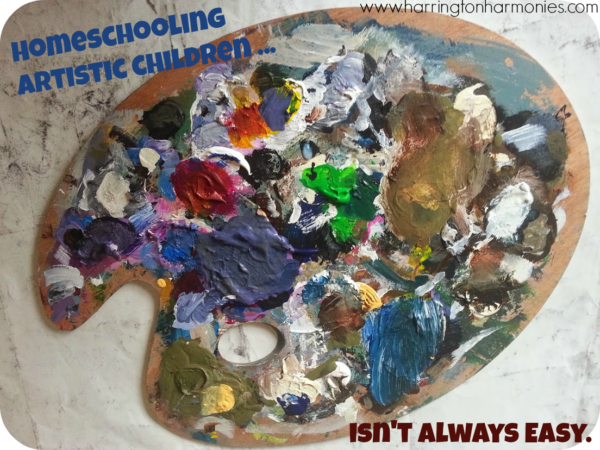 Homeschooling Artistic Children isn’t easy.
Homeschooling Artistic Children isn’t easy.
Homeschooling any child isn’t easy. It’s a full time job! And in some ways, artistic kids can be even more challenging. They don’t necessarily fit into even the “homeschool box”. As I mentioned, artistic children often have other learning challenges or exceptions such as ADHD, Bipolar Disorder, Dyslexia, Autism, and so on. Therefore, a packaged curriculum may not work well for them. They will approach things often in unusual ways. Rely on yourself as their teacher and see materials as tools only. This will make both you and them happier on a daily basis. Use goals to measure your success and have a routine that gives your day dependability and order.
A work from my daughter in high school:
Routines provide artistic children with a framework for success.
With routine, I am much more flexible now than I used to be. I have found that I can be more flexible with my less artistic child and we can still get some schooling accomplished. That was not the case with my artistic children. All children need order, but I think it’s especially important with artistic children. They will go wherever the wind takes them if allowed. What I found worked best for us was an order of events and not a time schedule. I found that if they did the same order of things each day then they knew what to expect and we had fewer battles to get work done. It didn’t matter how long each task took as long as it was in the same order. My ADHD child benefited twice from this approach. He always worked better if he knew what to expect.
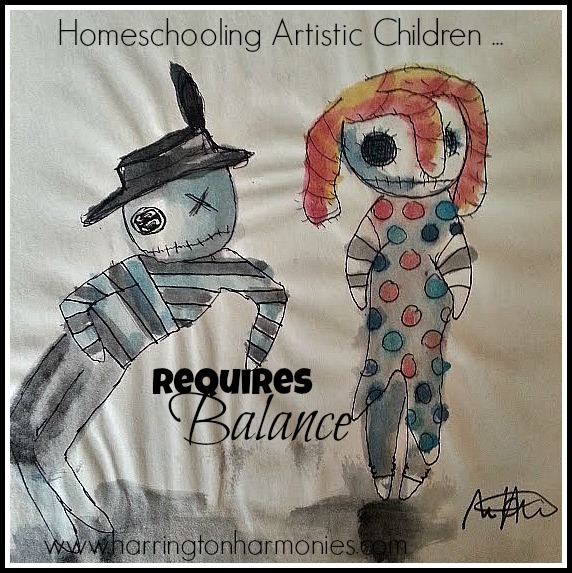
Finding the Creative Balance
Like art, homeschooling also has balance. One of my biggest challenges was to find the balance between letting them be free to express themselves and meeting my objective for their learning at the same time. I can’t really tell you what the perfect balance is. It took me lots of trial and error in finding it myself. It was tough and I did not find it with perfection. However, I always try to strive for it. You must find it for yourself. But I can tell you a few things I wish I knew starting out.
Things I wish knew when I began Homeschooling my Artistic Children:
- It’s okay to base your school year on goals, not a program or curriculum someone else wrote. Your measurable goals can be the foundation of your program.
- All learning is integrated. Don’t limit yourself or them to a textbook just because you bought it.
- Adapt a packaged curriculum…a lot! As I said, truly artistic children are often twice exceptional. So a package deal will probably not address your child’s needs but are a good starting point.
- Some things only improve with time and development. It usually takes longer than you think. Be consistent.
- Twice exceptional kids are a challenge to teach. It’s okay to have bad homeschool days.
- Being artistic isn’t a free for all. Routine is essential and ultimately fosters their creativity.
My son’s drawings around tenth grade:
Ways to Teach Creative Kids:
Through Literature-
There is no substitute for good literature. With my artistic children I did not teach them a formal grammar class, only the basic parts of speech. Because they read so many classic books and were strong readers they didn’t need grammar lessons- at least not formal ones. I know this is a radical approach. But why do rote lesson after lesson if your child doesn’t need it?
They read far more full books than most children do. I selected literature wisely and made sure it was of the highest quality. We did not spend time on “twaddle” as Charlotte Mason termed it. Reading was a major part of our homeschooling. I can’t stress it enough. Your creative child will love great literature but most likely won’t enjoy a boring grammar text. They will get the same information from both. It will depend on how your child learns if you think you can take this approach or not. How well they read and write must also be taken into consideration. My children were advanced for their age and did not need the extra instruction, however some children still might. Either way, great books are a homeschooling centerpiece.
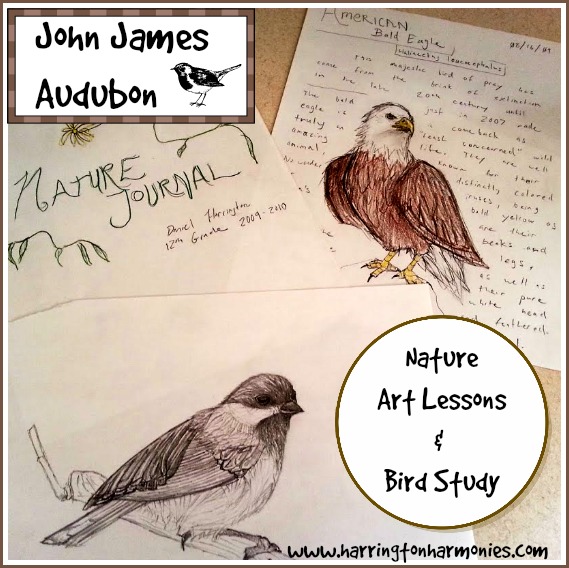 With Biographies-
With Biographies-
History can come to life when put in the context of a real person’s life. A wonderful book that is interesting that takes this approach is George Washington’s World and the others in the series by Genevieve Foster. I never liked history myself in school because textbooks were so dull to me. As a homeschool teacher, history is a big part of our program. Using timelines and living books have made history more interesting.
I also teach art using biographies. Next year I plan to begin developing art lessons through the ages which will teach some history through art or can be used to compliment history and geography with an art lesson.
Start a science unit on insects with learning about Henri Fabre or another scientist. For middle or high school students read Fabre’s Book of Insects or do a study on John James Audubon!
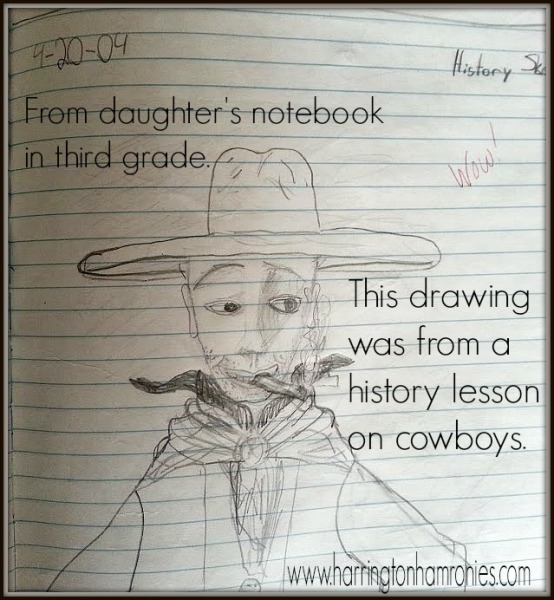 Through Drawing-
Through Drawing-
Just giving your artistic child a pencil and sketchbook can be their passport to new discoveries. A variety of art supplies are wonderful but can get expensive. If your child likes to draw don’t underestimate the value of a sketchbook and pencil. I used the fact that they liked to draw often to my teaching advantage.
For example, it kept them engaged in a read aloud, history lesson, science book, etc. that they may not have normally sat still for. I always insisted that they drew about what was being read. That way it got them engaged with the story or lesson and not on some random thing they wanted to be thinking about. It worked well for us. We always did our read-alouds before bed and they would beg me to keep reading them! They thought they were just getting to stay up late but I knew better. We were doing school!
From my son’s nature journal 12th grade- .5 credit Natural History Course:
 A nature journal is an excellent way to work science in for the artistic type. They can draw and record their finding and explore their environments. Just imagine what other subjects or topics can be taught with drawing?
A nature journal is an excellent way to work science in for the artistic type. They can draw and record their finding and explore their environments. Just imagine what other subjects or topics can be taught with drawing?
By Theme, Topic or with a project-
I myself very much enjoy doing a unit based on a topic or theme. I think because it can be so integrated that way. There is most definitely a time to work out of a text book or workbook. There is certainly value in them and a time for them. However, they do not grant the kind of freedom and exploratory learning that a theme, topic, or project can provide. Your child may go in a totally different direction on a subject that a textbook written for them might.
This type of learning can be done at any level. Just make it appropriate for their grade level and ability. Provide them with great books and resources from the library. Older children should research on the internet as well. Have them create a project, experiment, paper/report, speech, or other work from what they learned about the topic. help them organize their process with outlines or graphic organizers.
Here is a sample from a group newspaper/newsletter project:
 There is no limit to what they will come up with. A girl that can sew may create a quilt when learning about the 50 states, a square per state perhaps. A young man with an interest in creative writing might learn about frogs and amphibians for science and then use that information toward a science fiction short story called “The Creature”. Present the info and then have your child research and collect data. Give them a rubric so you can be sure that they are meeting your requirements for the project and them let them go for it. If you grade them, use the meeting of the requirements on the rubric for giving the grade.
There is no limit to what they will come up with. A girl that can sew may create a quilt when learning about the 50 states, a square per state perhaps. A young man with an interest in creative writing might learn about frogs and amphibians for science and then use that information toward a science fiction short story called “The Creature”. Present the info and then have your child research and collect data. Give them a rubric so you can be sure that they are meeting your requirements for the project and them let them go for it. If you grade them, use the meeting of the requirements on the rubric for giving the grade.
In order to stay on track, determine the topics you want to cover at the beginning of the year and write up a scope and sequence.
 Homeschooling Artistic Children with Journals-
Homeschooling Artistic Children with Journals-
Looking back my favorite period of homeschooling was when we “unschooled” with journals. I sometimes refer to this period as our Charlotte Mason years. For three years while living overseas we simple explored and the kids wrote in their journals.
To use journals in this way children should be able to read and write fluently. Otherwise the idea will be very frustrating. If they aren’t writing yet they can draw. It is perfect for a relaxed homeschool, unschooling, or a delight directed approach. It also proved to be good for providing a transition from the end of elementary to the beginning of high school, preparing them for writing papers by doing mini reports and small research papers.
Over time they became a wonderful record of what we did during the middle school years which also meant I didn’t need to record. One journal represents 2-3 years of our homeschooling. Read more about How to Homeschool with Journals.
Homeschooling Artistic Children with Games
Games are a fun way to learn. They truly can be beneficial in many ways. I think the key here is balancing games with other forms of learning. An avid gamer can simply spend too much time playing. Therefore, I recommend that you have an active role in choosing what games your child gets to play and why. Be purposeful and find games that he likes and that you feel he is really learning from. Seek out educational games and then use them to your advantage.
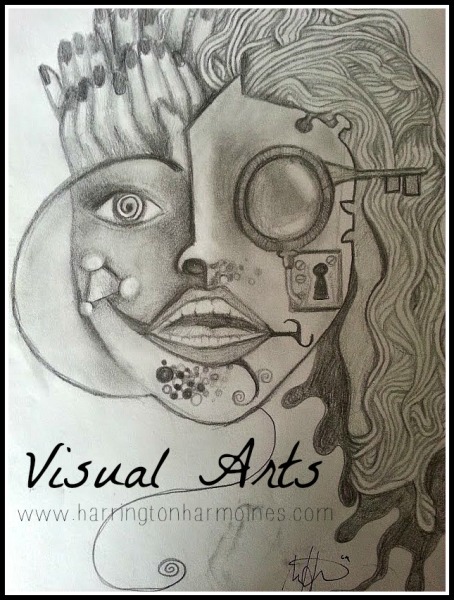
Visual Arts (Drawing, Painting and More!)
You can get tons of ideas for free that can aid you in your artistic endeavors with your children. I hope that you will check out my Free Art Lessons By Artist as a possiblitiy. I also have a recommended art supplies list you may find helpful if you yourself have no visual art background or interest. My list is less crafty and more painting and drawing oriented. One of the best things you can do to encourage your child’s creativity is to have materials available and outlets for exploring. Creative kids seem to do the rest on their own. At a minimum your child should have a journal or notebook and a portfolio for keeping their best works! Here are a few helpful how to teach art posts:
 |
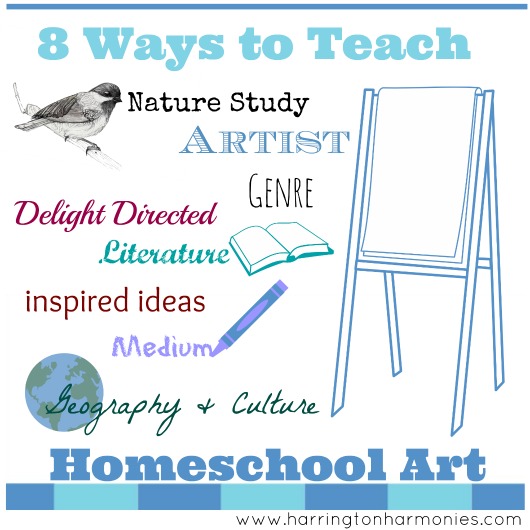 |
My Art Subscriber Freebies:
 |
 |
Favorite and Recommended Visual Art Resources:
- Teaching Art with Story Book Illustrations from The Curriculum Choice
- Teaching Art in The Homeschool, You CAN Be and Artist and Tips and Tutorials from Tricia @ Hodgepodge
- Chalk Pastel Art for All Ages Curriculum from Southern Hodgepodge
- Harmony Fine Arts Program from Barb
- A is for Art options for homeschoolers from Sara @ My Joy Filled Life
- FREE Homeschool Art List of over 20 art resources from Amy @ Amy’s Wandering.
- Free Art Lessons by Artist here on Harrington Harmonies
- Free Art Curriculum Gr. 1-7 goes by Artist from Tina@ Tina’s Dynamic Homeschool
- Teaching Homeschool Art Google+ Hangout from iHomeschool Network
- Ultimate list of Inexpensive Art Projects from Angie at Many Little Blessings
- 20 DIY Art Supplies from Free Homeschool Deals
- Popular List of Homeschool Art and Music Curriculum from Karyn @ Teach Beside Me
- Bonza Draw App
Thinking Outside the Homeschool Box for Teaching Creative Kids:
- Unschooling Fine Arts and 5 Days of Video Game Learning from Joan @ Unschool Rules
- How an Art Box Inspires from Tricia @ Hodgepodge
- How I Teach Fine Arts to Multiple Children with Special Needs from Sharla @ The Chaos and he Clutter
- Project Based Learning from Cindy @ Our Journey Westward
- Sharpie Projects Kids Will Love from Mary @ Homegrown Learners
- How Dad Approaches Art Differently Than Mom from Joyful Socks Mom
- Big List of Games for the Arts from Kathy @ Cornerstone Confessions
- Lynda.com Training Library
- Electives and Extracurricular and How to Let Summer Happen from Tricia @ Hodgepodge
Creative Writing, Poetry and Storytelling:
- From Susan Evans- How to Write a Mystery Story and Time Travel- How to Write Historical Fiction for Kids
- Inspiring Kids with Poetry
- Storytelling with Legos
- New Millennium Girls Creative Writing
What about Math? You can’t be creative with that can you?
- Math with Art– fraction, shapes with Klee
- Living Math from Cindy @ Our Journey Westward
- The Crafty Side of Math from Heather @ Blog She Wrote
Music:
- 9 Ways to Incorporate Music by Kathy on Managing Your Blessings
- Ultimate List of Online Music Education Activities from Kathy @ Cornerstone Confessions
- Squilt from Mary @ Homegrown Learners
- Squilt Website
- Music Appreciation from the Chaos and the Clutter
Crafts and Sewing:
- Steam Punk Fashion Design from Heather @ Blog She Wrote. She has numerous sewing projects on her blog.
- Beginning Sewing for Little Ones from Karyn @ Teach Beside Me
- 10 Crafts for Encouraging Creative Kids from Heidi @ Home Schoolroom
Science & History:
- Study Science with Art
- How to Nature Journal
- Tips for Botanical Illustrating from Blog She Wrote
- Study History with Art
Get Cooking!
Photography:
Find More Utimate Guides Here:



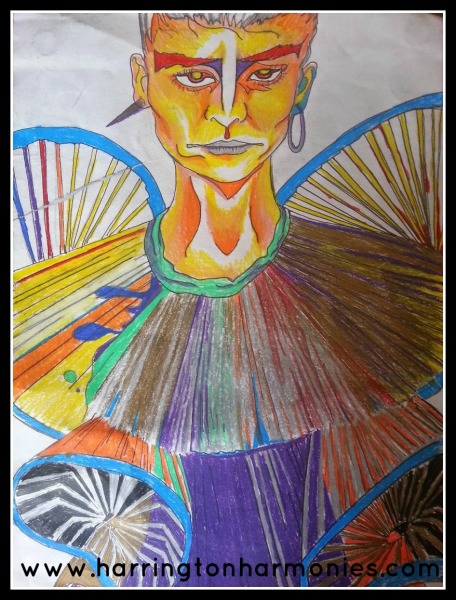
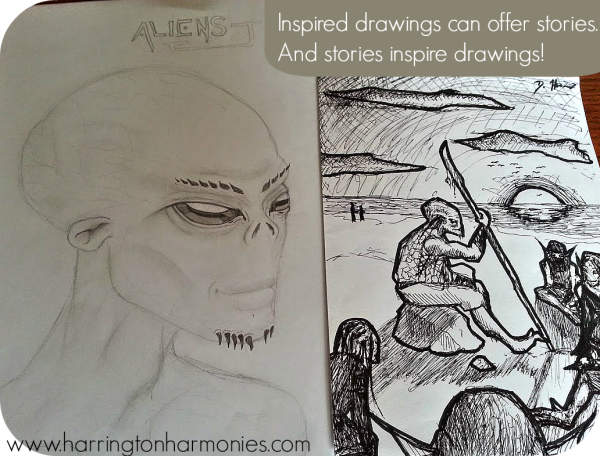







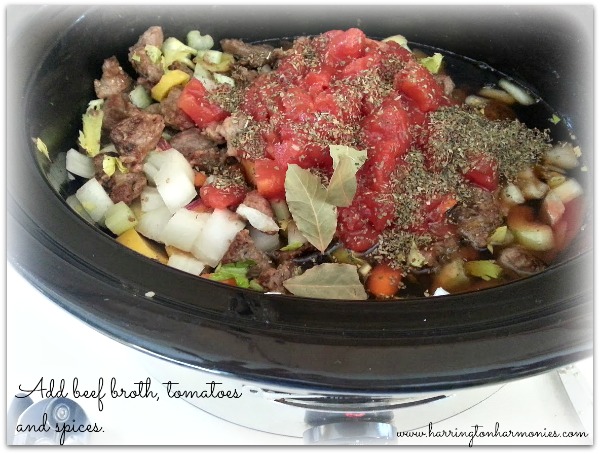





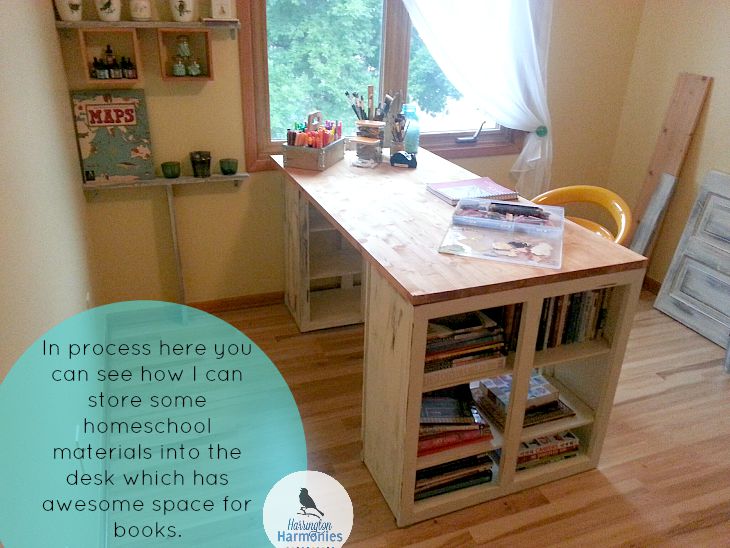






4 Comments
Rina
This is just awesome! I homeschool my highly creative 8 year old girl and after 1 and 1/2 years, I can say I am only just now beginning to get a sense of what balance works in our house .. your post both confirmed and validated some things I have discovered for myself, and also gave me a sense of direction and inspiration for our future years. Thanks for a wonderful post.
Stephanie
Oh Rina, you are so very welcome! I live for comments like this and it makes me feel great that I can affirm you in what you real already know. But being a homeschool mom myself, I understand importance of another person who can relate. I can sense you’re doing terrific job from the fact that your are finding that balance. Many blessings on your journey!
Kalista
Thank you so much for this!! My daughter is very artistic and we have been struggling. I knew I needed to alter some things for her but had no idea how. This ha given me some great ideas! Thank you SO much!
Heather Woodie
Lovely post Stephanie! Thanks!